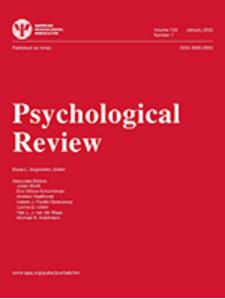The memory and identity theory of ICD-11 complex posttraumatic stress disorder.
IF 5.1
1区 心理学
Q1 PSYCHOLOGY
引用次数: 3
Abstract
The 11th version of the International Classification of Diseases (ICD-11) includes complex posttraumatic stress disorder (CPTSD) as a separate diagnostic entity alongside posttraumatic stress disorder (PTSD). ICD-11 CPTSD is defined by six sets of symptoms, three that are shared with PTSD (reexperiencing in the here and now, avoidance, and sense of current threat) and three (affective dysregulation, negative self-concept, and disturbances in relationships) representing pervasive "disturbances in self-organization" (DSO). There is considerable evidence supporting the construct validity of ICD-11 CPTSD, but no theoretical account of its development has thus far been presented. A theory is needed to explain several phenomena that are especially relevant to ICD-11 CPTSD such as the role played by prolonged and repeated trauma exposure, the functional independence between PTSD and DSO symptoms, and diagnostic heterogeneity following trauma exposure. The memory and identity theory of ICD-11 CPTSD states that single and multiple trauma exposure occur in a context of individual vulnerability which interact to give rise to intrusive, sensation-based traumatic memories and negative identities which, together, produce the PTSD and DSO symptoms that define ICD-11 CPTSD. The model emphasizes that the two major and related causal processes of intrusive memories and negative identities exist on a continuum from prereflective experience to full self-awareness. Theoretically derived implications for the assessment and treatment of ICD-11 CPTSD are discussed, as well as areas for future research and model testing. (PsycInfo Database Record (c) 2023 APA, all rights reserved).ICD-11复杂创伤后应激障碍的记忆与认同理论。
第11版国际疾病分类(ICD-11)将复杂创伤后应激障碍(CPTSD)与创伤后应激障碍(PTSD)一起作为单独的诊断实体。ICD-11将CPTSD定义为六组症状,其中三组与创伤后应激障碍共有(此时此地的再体验、回避和当前威胁感),三组(情感失调、消极自我概念和关系障碍)代表普遍的“自我组织障碍”(DSO)。有相当多的证据支持ICD-11 CPTSD的结构有效性,但迄今为止尚未提出其发展的理论说明。需要一种理论来解释与ICD-11 CPTSD特别相关的几个现象,如长期和反复创伤暴露所起的作用,创伤后应激障碍和DSO症状之间的功能独立性,以及创伤暴露后的诊断异质性。ICD-11 CPTSD的记忆和身份理论指出,单一和多重创伤暴露发生在个体脆弱性的背景下,它们相互作用产生侵入性的、基于感觉的创伤记忆和消极身份,它们共同产生PTSD和DSO症状,这些症状定义了ICD-11 CPTSD。该模型强调,从前反思经验到完全自我意识,侵入性记忆和消极身份这两个主要且相关的因果过程存在于一个连续体上。讨论了对ICD-11 CPTSD的评估和治疗的理论推导意义,以及未来研究和模型测试的领域。(PsycInfo数据库记录(c) 2023 APA,版权所有)。
本文章由计算机程序翻译,如有差异,请以英文原文为准。
求助全文
约1分钟内获得全文
求助全文
来源期刊

Psychological review
医学-心理学
CiteScore
9.70
自引率
5.60%
发文量
97
期刊介绍:
Psychological Review publishes articles that make important theoretical contributions to any area of scientific psychology, including systematic evaluation of alternative theories.
 求助内容:
求助内容: 应助结果提醒方式:
应助结果提醒方式:


